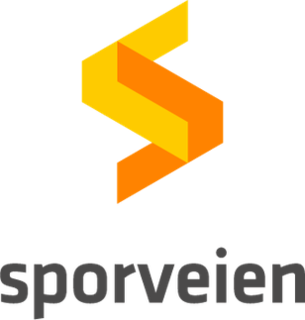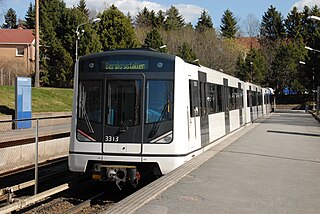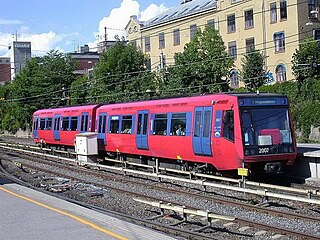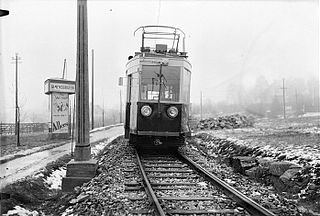Related Research Articles

The Norwegian railway system comprises 4,087 km of 1,435 mm track of which 2,622 km is electrified and 242 km double track. There are 696 tunnels and 2,760 bridges.

The Oslo Metro is the rapid transit system of Oslo, Norway, operated by Sporveien T-banen on contract from the transit authority Ruter. The network consists of five lines that all run through the city centre, with a total length of 85 kilometres (53 mi), serving 101 stations of which 17 are underground or indoors. In addition to serving 14 out of the 15 boroughs of Oslo, two lines run to Kolsås and Østerås, in the neighboring municipality of Bærum. In 2016, the system had an annual ridership of 118 million.

Sporveien Oslo AS is a municipally owned public transport operator in Oslo, Norway. It operates the trackage and maintains the stock of the Oslo Metro and Oslo Tramway, as well as owning eight operating subsidiaries. In 2005, its 2,365 employees transported 160 million passengers 710 million kilometers, and since 2008 it has operated on contract with the public transport authority Ruter.

The Sognsvann Line is a rapid transit line on the Oslo Metro of Norway. It branches from the Common Tunnel at Majorstuen and runs 6.0 kilometers (3.7 mi) to Sognsvann. After Ullevål stadion, the Ring Line branches off. The Sognsvann Line serves the northwestern and northern neighborhoods of Oslo, mostly within the borough of Nordre Aker. The line is owned and maintained by Kollektivtransportproduksjon and has nine stations. The western end of line 5 serves the entire line. Line 4 and the eastern end of line 5 serve the southern part of the line up to Ullevål stadion before branching off and continuing along the Ring Line. This gives an average five-minute headway on the southern part and an average fifteen-minute headway on the northern part of the line.

The Lambertseter Line is a 5.9-kilometer (3.7 mi) line on the Oslo Metro which runs from Brynseng to Bergkrystallen. It further shares track with the Østensjø Line along the 2.5-kilometer (1.6 mi) section from Tøyen to Brynseng. The line runs through a primary residential area of Nordstrand, serving neighborhoods such as Manglerud, Ryen and Lambertseter. The line is served by Line 4 of the metro, which runs every fifteen minutes. This is supplemented by Line 1 that is extended to Bergkrystallen between 6:30 and 19 on weekdays, giving a combined frequency of eight trains per hour.

T1000 and T1300 were two rapid transit train classes used on Oslo Metro in Oslo, Norway. The 197 cars were built by Strømmens Verksted, Norsk Elektrisk & Brown Boveri and AEG between 1960 and 1981. They were the first metro trains used in Oslo, and had remained in active use until being replaced by OS MX3000 trains in 2007. Each car is equipped with a driver's cab at one or both ends and four motors, each with 98 kilowatts (131 hp). The cars are 17 meters (56 ft) long, 3.2 meters (10 ft) wide and 3.65 meters (12.0 ft) tall. The trains use 750 V current, and are capable of 70 kilometres per hour (43 mph). Signaling is provided through automatic train protection.
The OBX Index is a stock market index which lists the 25 most liquid companies on the main index of the Oslo Stock Exchange in Norway. All stocks on the OBX list can be traded with options and futures. The companies on the OBX list are rotated twice a year, on the third Friday of June and December. Its Record High is 670,06 set on August 7 2017

AS Oslo Sporveier is a defunct municipal owned company responsible for public transport in Oslo, Norway. It was created in 1924 to take over the city's two private tram companies. In 1927 its started with bus transport, including from 1940 to 1968 trolleybuses. Since 1966 rapid transit and from 1985 water buses have also been operated by the company. It was split into two separate companies in 2006; Kollektivtransportproduksjon took over the operation while Oslo Public Transport Administration was responsible for buying the services, fare regulation and marketing. The latter merged into Ruter in 2008, when the Oslo Sporveier brand was discontinued.

MX3000 is an electric train used on Oslo Metro in Oslo, Norway. The multiple units are produced by Siemens, who started serial delivery in 2007. Seventy-eight three-car units were ordered by Sporveien, and five by Akershus County Municipality. They replaced the older T1000 and T1300 stock that was used on the Oslo Metro since 1966. By 2010, the last T1000 and T1300 trains had been retired and replaced by 83 three-car units. 32 additional sets were ordered, and the final train set was delivered in 2014, increasing the fleet to 115 units.

T2000 was an electric train formerly used on the Oslo Metro of Oslo, Norway. Six double-car multiple units were built by Strømmens Verksted and AEG in 1994. Each was 18 metres (59 ft) long, and could carry 185 passengers, of which 60 could be seated in two compartments per car. Maximum speed was 100 km/h (62 mph). Bought by Oslo Sporveier, they were owned by Kollektivtransportproduksjon, and operated by Oslo T-banedrift.

Østhorn is a station on the Sognsvann Line of the Oslo Metro in Norway. It is located 7.1 kilometres (4.4 mi) from Stortinget station between Tåsen and Holstein stations. As one of the original stations on the line, Østhorn was opened on 10 October 1934. Nordberg was formerly the next northbound station, but it was closed in 1992, when the Sognsvann Line was upgraded to metro standard. Østhorn is located near a hill named Havnabakken, where local residents toboggan at winter's time.
Strømmens Værksted A/S was an industrial company based in Skedsmo, Norway, specialising in the production of rolling stock. Founded in 1873, it remains as a part of Bombardier Transportation. The plant is located just off Hovedbanen west of Strømmen Station.

The Ekeberg Line is a 6.6-kilometre (4.1 mi) long light rail line of the Oslo Tramway which runs from Gamlebyen to Ljabru in Oslo, Norway. Operated by lines 13 and 19, it serves the area of Nordstrand and the neighborhoods of Ekeberg, Jomfrubråten, Bekkelaget and Ljan. The line is operated by Oslo Sporvognsdrift using SL79 and SL95 trams on contract with Ruter. The line itself is owned by Sporveien. At Oslo Hospital, the line connects to the Bjørvika Line, which runs to the city center.

The Simensbråten Line was a light rail line of Oslo Tramway between Jomfrubråten and Simensbråten in Oslo, Norway. Opening on 30 September 1931, it branched off the Ekeberg Line at Jomfrubråten and had three stops along the 1.5-kilometer (0.9 mi) route—Ekebergparken, Smedstua and Simensbråten. Operated by Ekebergbanen, the line was closed on 29 October 1967. It is the only light rail line in Oslo to have been closed.

Vestgrensa was a light rail station on the Sognsvann Line of the Oslo Metro in Norway. It opened on 10 October 1934, and was located between Blindern and Ullevål stadion stations. The station was rebuilt when the Sognsvann Line was upgraded from light rail to metro standard in the early 1990s. It was closed on 22 August 1999, when it was replaced by the new station Forskningsparken.

The history of the Oslo Tramway and Oslo Metro in Oslo, Norway, starts in 1875, when Kristiania Sporveisselskab (KSS) opened two horsecar lines through the city centre. In 1894, Kristiania Elektriske Sporvei (KES) built the first electric street tramways, which ran west from the city centre. Within six years, all tramways were electric. The city council established Kristiania Kommunale Sporveie (KKS) in 1899, which built three lines before it was sold to KSS six years later. Both KSS and KES were taken over by the municipality in 1924, becoming Oslo Sporveier. The company gradually expanded the city tram network, which reached its peak length in 1939.

The rolling stock of Oslo Metro, Norway has consisted of three classes: T1000/T1300, T2000 and MX3000. The T1000 was built as 162 single cars from 1964 to 1978. From 1979 to 1985, 33 new T1300 trains were built, followed by the conversion of 16 T1000s. Six two-car T2000 units were delivered in 1994. Since 2005, the first 83 three-car MX3000 units have been replacing the older stock, and the last T1000 was retired in 2007. From 2010, only MX3000-trains are in use. The T1000/T1300 and T2000 were built by Strømmens Værksted, with motors from Norsk Elektrisk & Brown Boveri (NEBB) and AEG, respectively, and the MX3000 were built by Siemens.
AS Ekebergbanen was a private company that built and operated the Ekeberg Line in Oslo, Norway. It was founded 27 March 1914, and the line opened 11 June 1917 from Stortorvet to Sæter. The company also built a line to Simensbråten that was closed 29 October 1967. Ekebergbanen also operated buses in Oslo.
Høyer-Ellefsen A/S was a Norwegian company. It was established in 1896 by the ingenieur Sigurd Høyer-Ellefsen. He was managing director until 1925. In 1902, it became a stock based company. In 1981, the company was taken over by Orkla, that merged the company with Astrup & Aubert, making a new company called "Astrup Høyer". Astrup Høyer was taken over by Aker Norcem in 1986 and was rebranded to "Aker Entreprenør". The company was acquisited by Veidekke in 1991.
References
- ↑ Tvedt, Knut Are, ed. (2010). "Oslo Vognselskap AS". Oslo byleksikon (in Norwegian) (5th ed.). Oslo: Kunnskapsforlaget. p. 440. ISBN 978-82-573-1760-7.
- ↑ Skomakerstuen, Bjørn (22 December 2010). "Flere T-banevogner". Aftenposten Aften (in Norwegian). p. 12.